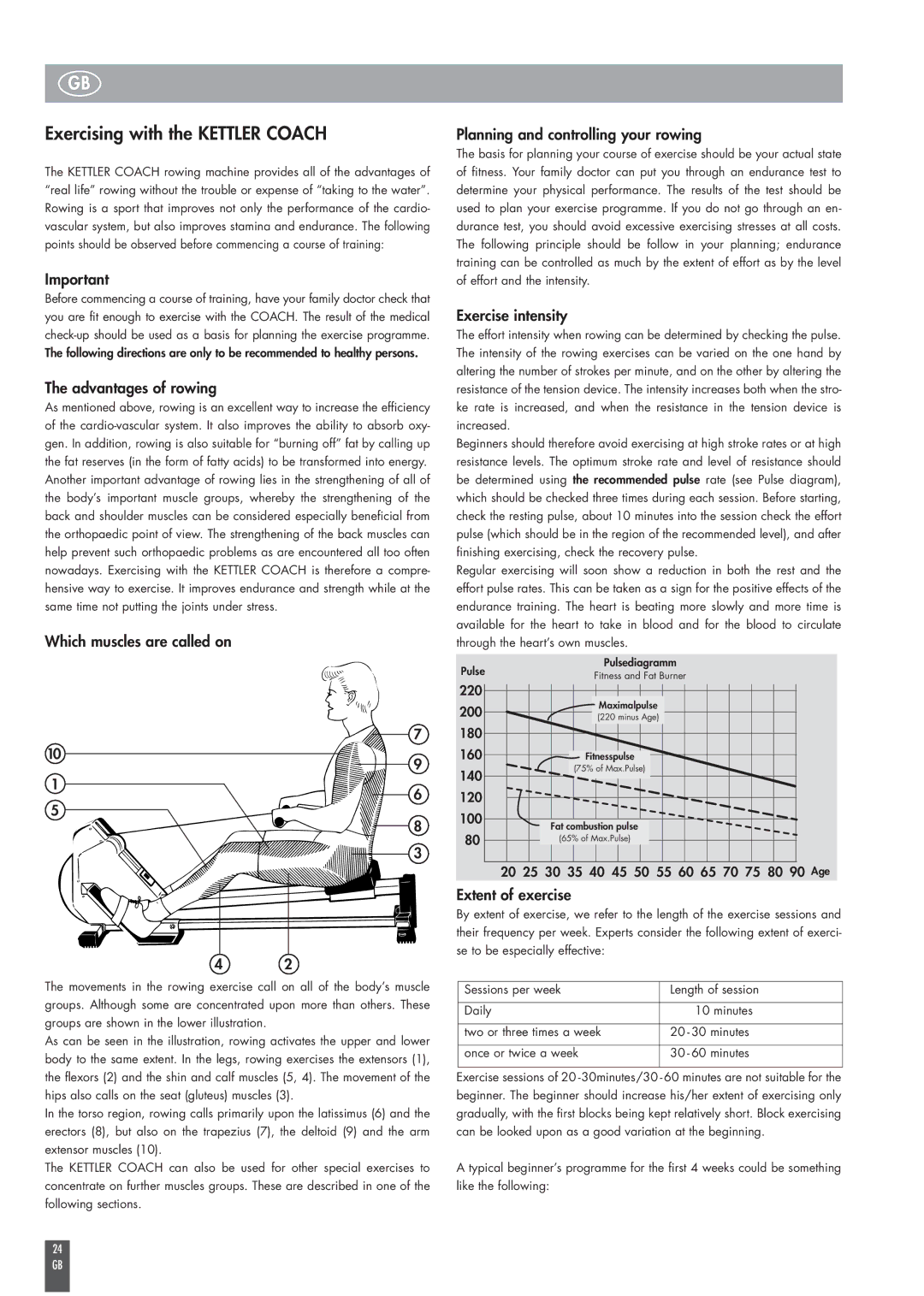
GB
Exercising with the KETTLER COACH
The KETTLER COACH rowing machine provides all of the advantages of “real life” rowing without the trouble or expense of “taking to the water”. Rowing is a sport that improves not only the performance of the cardio- vascular system, but also improves stamina and endurance. The following points should be observed before commencing a course of training:
Important
Before commencing a course of training, have your family doctor check that you are fit enough to exercise with the COACH. The result of the medical
The advantages of rowing
As mentioned above, rowing is an excellent way to increase the efficiency of the
Which muscles are called on
Planning and controlling your rowing
The basis for planning your course of exercise should be your actual state of fitness. Your family doctor can put you through an endurance test to determine your physical performance. The results of the test should be used to plan your exercise programme. If you do not go through an en- durance test, you should avoid excessive exercising stresses at all costs. The following principle should be follow in your planning; endurance training can be controlled as much by the extent of effort as by the level of effort and the intensity.
Exercise intensity
The effort intensity when rowing can be determined by checking the pulse. The intensity of the rowing exercises can be varied on the one hand by altering the number of strokes per minute, and on the other by altering the resistance of the tension device. The intensity increases both when the stro- ke rate is increased, and when the resistance in the tension device is increased.
Beginners should therefore avoid exercising at high stroke rates or at high resistance levels. The optimum stroke rate and level of resistance should be determined using the recommended pulse rate (see Pulse diagram), which should be checked three times during each session. Before starting, check the resting pulse, about 10 minutes into the session check the effort pulse (which should be in the region of the recommended level), and after finishing exercising, check the recovery pulse.
Regular exercising will soon show a reduction in both the rest and the effort pulse rates. This can be taken as a sign for the positive effects of the endurance training. The heart is beating more slowly and more time is available for the heart to take in blood and for the blood to circulate through the heart’s own muscles.
10
7
9
Pulse |
| Pulsediagramm | |||||
| Fitness and Fat Burner | ||||||
220 |
|
| |||||
|
|
|
|
|
|
| |
|
|
|
|
|
|
| |
200 |
|
| Maximalpulse |
| |||
|
| (220 minus Age) |
| ||||
180 |
|
|
|
|
|
|
|
|
|
|
|
|
|
| |
160 |
|
|
|
|
|
|
|
|
| Fitnesspulse |
|
| |||
|
|
| |||||
140 |
| (75% of Max.Pulse) |
| ||||
|
|
|
|
|
|
| |
|
|
|
|
|
|
| |
1
6
5
8
3
4 2
The movements in the rowing exercise call on all of the body’s muscle groups. Although some are concentrated upon more than others. These groups are shown in the lower illustration.
As can be seen in the illustration, rowing activates the upper and lower body to the same extent. In the legs, rowing exercises the extensors (1), the flexors (2) and the shin and calf muscles (5, 4). The movement of the hips also calls on the seat (gluteus) muscles (3).
In the torso region, rowing calls primarily upon the latissimus (6) and the erectors (8), but also on the trapezius (7), the deltoid (9) and the arm extensor muscles (10).
The KETTLER COACH can also be used for other special exercises to concentrate on further muscles groups. These are described in one of the following sections.
24 GB
120 |
|
|
|
|
|
|
|
|
|
|
|
|
|
|
|
|
|
| |
100 |
|
|
|
|
|
|
|
|
|
|
| Fat combustion pulse |
| ||||||
80 |
|
|
| ||||||
|
|
| (65% of Max.Pulse) |
| |||||
|
| ||||||||
|
|
|
|
|
|
|
|
|
|
20 25 30 35 40 45 50 55 60 65 70 75 80 90 Age
Extent of exercise
By extent of exercise, we refer to the length of the exercise sessions and their frequency per week. Experts consider the following extent of exerci- se to be especially effective:
Sessions per week | Length of session |
|
|
Daily | 10 minutes |
|
|
two or three times a week | 20 - 30 minutes |
|
|
once or twice a week | 30 - 60 minutes |
|
|
Exercise sessions of 20
A typical beginner’s programme for the first 4 weeks could be something like the following:
